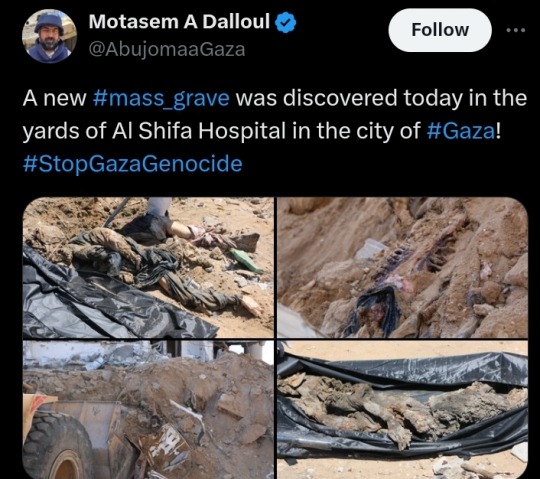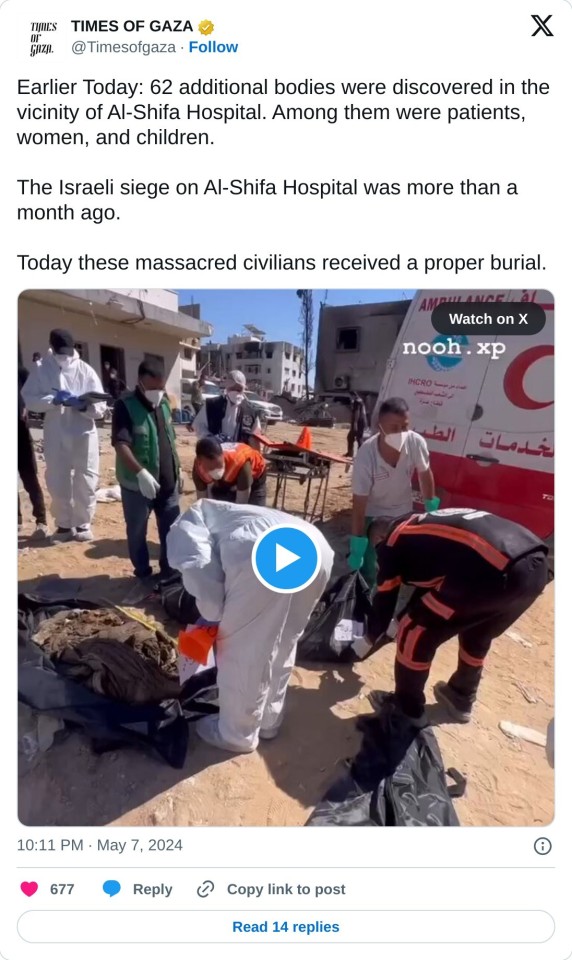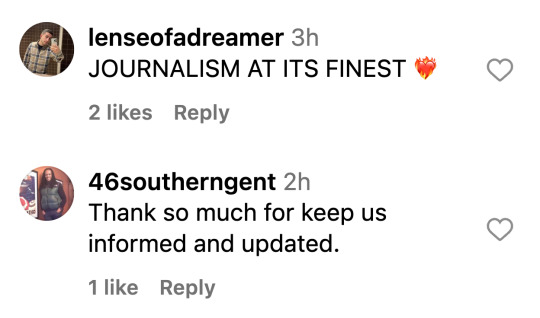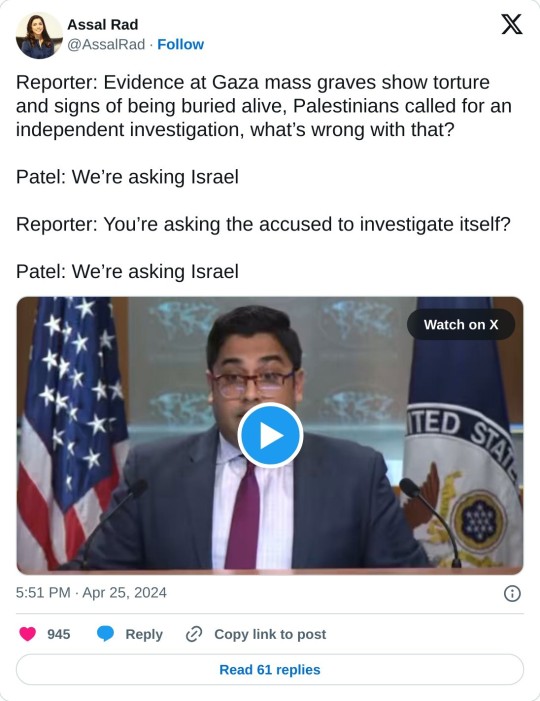#al-nasser hospital
Explore tagged Tumblr posts
Text
the end of bisan’s live from tonight, January 16th 2024. Please share, contact representatives, call for a ceasefire, don’t stop talking about Palestine!!! Call for a global strike January 21st!
#bisan#wizard bisan#Palestine#free Palestine#anti Israel#Israel#idf#fuck idf#fuck Israel#anti colonialism#anti Zionism#press#News#journalism#urgent#al-nasser hospital
400 notes
·
View notes
Text

The health system is crumbling, they're calling repeatedly for help and fuel and they're not getting either. I cannot believe I'm watching this happen in real life, in real time, in this fucking century.
#free gaza#free palestine#gaza strip#irish solidarity with palestine#palestine#gaza#news on gaza#al jazeera#boycott israel#israel#Jerusalem#Colonialism#News#Current events#Latest news#Al-Quds Hospital#Al-Shifa Hospital#Al-Nasser Hospital
92 notes
·
View notes
Text


Over 400 people have been found in mass graves in Al Shifa Hospital and Nasser Hospital so far
#yemen#jerusalem#tel aviv#current events#palestine#free palestine#gaza#free gaza#news on gaza#palestine news#news update#war news#war on gaza#al shifa hospital#nasser hospital#gaza genocide#genocide#Dear bodies tw#Bodies tw#Corpses tw#edited
1K notes
·
View notes
Text
Israeli attacks have damaged or destroyed:
• 380,000 housing units
• 412 schools and universities
• 556 mosques
• three churches
• 206 archeological and heritage sites
• knocked 32 hospitals and 53 health centres out of service
• 126 ambulances also targeted
All violations of the Geneva Convention
#NoOneAboveTheLaw
#palestine#palestinians#gaza#genocide#mass murder#mass graves#israeli apartheid#israeli occupation#idf terrorists#iof terrorism#right wing extremism#war crimes#justice#free palestine#free gaza#humanitarian crisis#settler colonialism#childrens holocaust#nasser hospital#al shifa hospital#rafah#us weapons#us complicity#biden administration#netanyahu#netanyahu the madman#annexation#land grab#state theft#geneva convention
236 notes
·
View notes
Text


#nuseirat refugee camp#israeli raid#gaza massacre#eu condemnation#palestinian casualties#gaza health ministry#al-aqsa hospital#nasser hospital#doctors without borders#humanitarian crisis#gaza conflict#medical emergency#refugee camp attack#israeli-palestinian conflict#civilian casualties#health crisis#international outrage#idf operation#humanitarian aid#medical facilities overwhelmed#israel#west bank#international law#illegal occupation#palestine#human rights#israeli settlements#united nations#middle east conflict#international community
109 notes
·
View notes
Text
People are still saying, "but Hamas" "Oct 7th" "Israel has the right to defend itself" after the amount of mass graves discovered? MASS GRAVES?
This world is truly khalas.
sbeih.jpg
Al Jazeera
#palestine#free palestine#free gaza#free west bank#gaza#gaza strip#israel#genocide#social justice#human rights#al jazeera#palestine news#middle east#protest#save gaza#us politics#mass graves#nasser hospital#al shifa hospital
68 notes
·
View notes
Text

KHAN YOUNIS 🇵🇸 - A Palestinian woman cradling the body of her young niece. The photograph, taken by Mohammed Salem just days after his own child was born, shows 36-year-old Inas Abu Maamar holding five-year-old Saly, who was killed along with her mother and sister when an Israeli missile struck their home. (source)
#politics#palestine#israel#inas abu maamar#nasser hospital#gaza#rafah#al nasser hospital#khan younis#mohammed salem#photography#photojournalism#photo of the year#war crimes#israel is a terrorist state#collective punishment#🇵🇸
83 notes
·
View notes
Text
repost from @amnestyuk:
Last week, 179 healthcare workers from across the UK gathered outside St Thomas’ Hospital to demand freedom and justice for the 179 Palestinian healthcare workers who are detained without charge or trial by Israeli forces.
Among those in secret detention is Dr. Khaled Al Serr, who was taken in March this year from Nasser Hospital in Khan Younis. His family have yet to see him or hear from him.
These healthcare heroes should be saving lives, not facing torture or being criminalised. We urgently call on the UK government to demand the Israeli authorities reveal the whereabouts of these healthcare workers and release them immediately.
#palestine#human rights#free palestine#gaza#israel#free gaza#gaza genocide#healthcare#healthcare workers#doctors#Dr ghassan abu sittah#Dr khaled Al serr#palestinian hostages#palestinian genocide#the lancet#surgeon#doctor#israel is committing genocide#israel is a terrorist state#israeli war crimes#boycott israel#nasser hospital
36 notes
·
View notes
Text
by Stacey Mattews
The Biden White House has also said they want “answers”:
“We want answers,” National Security Advisor Jake Sullivan told reporters. “We want to see this thoroughly and transparently investigated.” A spokesperson for the US State Department also said Washington was continuing to press Israel for more information.
As with most things claimed by a Hamas-run organization, the problem here is that the mass grave was actually dug in January 2024 – but not by the IDF:
Analyses by Sky News and independent analysts of satellite imagery and footage published online found that claims spread by Hamas and Arabic media that the IDF had dug mass graves at the Nasser hospital in Gaza were false as the graves were made before the IDF entered the complex. Hamas, Al-Jazeera, and several news agencies claimed in recent days that the IDF had dug mass graves in order to “hide” the bodies of Palestinians after entering the Nasser hospital in Khan Yunis.
Here’s more from the Times of Israel:
The IDF, in its response, said that during its operation in the area of Nasser Hospital in recent months, troops examined corpses that had been buried by Palestinians on the medical center’s grounds, “as part of an effort to locate hostages.” The military said it operated in a “targeted manner,” only where it had intelligence that Israeli hostages may have been buried.
GeoConfirmed also has a lengthy thread that includes receipts that back up Shoshani’s statement. Make sure to click on the tweets to expand them for more detailed explanations:
The tweets are here
#mass graves#hamas#hamas lies#gaza#media bias#al jazeera#idf#nasser hospital#khan yunis#sky news#media hoax
26 notes
·
View notes
Text
#mass graves#al shifa hospital#gaza city#nasser hospital#khan younis#iof terrorism#fuck the iof#israeli war crimes#israeli apartheid#gaza strip#palestine#all eyes on rafah#useless nations#united nations#free palestine
19 notes
·
View notes
Text
By John Spencer
And yet, the U.S. encountered only sporadic use of hospitals in Afghanistan and Iraq. That does not appear to be the case in Gaza, where in almost every hospital the IDF has arrived at, it has uncovered and published military use by Hamas.
The terrorist group purposefully and systematically developed a strategy to use Gaza's hospitals for military purposes. Hamas knows the laws of war, it knows the public sensitivity, and it exploits those to both hamper the IDF's actions and invite international condemnation.
In Gaza's largest medical complex, the Al-Shifa hospital, the IDF found evidence that hostages were held there. They also found Hamas military weapons, ammunition, and equipment in many of the buildings in the complex. Most concerning was the presence of a large Hamas tunnel with a full command and control architecture utilizing the hospital's power sources that had been constructed purposely under the hospital grounds.
Meanwhile, Hamas was filmed firing at the IDF from within Sheikh Hamad Hospital. More Hamas militants fired a rocket-propelled grenade in front of the Al-Quds Hospital, then immediately ran inside.
The IDF found vehicles used in the October 7 massacre and a Hamas-built tunnel under the Indonesian Hospital. Weapons, ammunition, equipment, another tunnel, and evidence of hostages were found in the Al-Rantisi Hospital. Weapons hidden in incubators and evidence of a Hamas command center and base were found at the Kamal Adwan Hospital.
Most recently, the IDF found over 20 Hamas combatants who had taken part in the October 7 attacks hiding inside of the Al-Nasser Hospital in Southern Gaza. They also found vehicles used in the attack, Hamas weapons, and evidence that Israeli hostages had been held there.
To date, Israel has followed the rules when interacting with hospitals. It has provided warning before acting against hospitals suspected of Hamas use. And it has gone beyond the requirements of the law. It has facilitated evacuation, provided its own supplies to those present in the hospital, and helped provide alternative medical facilities until the ones being searched can restore full activities.
Perhaps most importantly, it appears that Israel has refrained so far from attacking hospitals from the air, even where it would be lawful to do so.
Instead, the IDF has sent in ground forces to search and destroy military infrastructure inside hospitals and detain terrorists hiding in them. It has sent doctors, Arabic speakers, and other specially trained staff to assist hospital staff and patients while the IDF is present. And it has left hospitals as quickly as possible, allowing them to resume full operations.
The fact that the International Committee of the Red Cross, World Health Organization, and United Nations have made public statements condemning Israel for searching hospitals, and never condemn Hamas for using the hospitals in the first place, is telling. During the war, and even more importantly, before the war, these organizations could have focused their efforts on stopping Hamas from exploiting hospitals and putting staff and patients in danger. Doing so would not only avoid the need for the IDF to operate within and near hospitals but would also send a message to all terrorist organizations that the world will not accept them putting in danger the very people who most need protection.
#hamas#gaza#terrorists#idf#hospitals#al rantisi hospital#al shifa hospital#al nasser hospital#weapons in hospitals#gaza hospitals
22 notes
·
View notes
Text
part of bisan’s live from tonight, January 16th 2024. Israel is bombing Al-Nasser hospital currently. Call for a global strike on January 21st!!
#bisan#wizard bisan#Palestine#free Palestine#Israel#idf#colonialism#watermelon#anti-Zionism#anti-israel#fuck israel#bombing#News#gaza#gaza strip#al-nasser hospital#war crimes#journalism#press
67 notes
·
View notes
Text





From the hour I've been gone, it's looking fucking grim.
Please stay alive Safwat
Link to the article in the 2nd image here:
#free gaza#free palestine#gaza strip#irish solidarity with palestine#palestine#gaza#news on gaza#al jazeera#boycott israel#israel#Daniel Hagari#Hamas#United Nations#al shifa hospital#al quds hospital#Al-Nasser Hospital#The Indonesian Hospital#The Turkish-Palestinian Friendship Hospital#Rafah#USA#Safwat al-Kahlout#Analysis#Marwan Bishara#Current events#Current news
19 notes
·
View notes
Text

#yemen#jerusalem#tel aviv#current events#palestine#free palestine#gaza#free gaza#news on gaza#palestine news#news update#war news#war on gaza#nasser hospital#nasser medical complex#al shifa hospital#gaza genocide#genocide#biden administration
2K notes
·
View notes
Text
"People in #Gaza have told us that the dead are the lucky ones, because the wounded suffer so acutely due to the Israeli authorities’ blockade of lifesaving aid"
- HRW
#palestine#palestinians#gaza#rafah#nuseirat#genocide#west bank#israeli atrocities#israeli apartheid#israeli occupation#war crimes#idf terrorists#iof terrorism#free palestine#free gaza#justice#al aqsa hospital#al shifa hospital#nasser hospital#civilian deaths#mass murder#child amputees#amputee#save the children#us weapons#us complicity#humanitarian crisis
22 notes
·
View notes
Text
How doctors in Gaza persevere amid Israel attacks | Israel War on Gaza News | Al Jazeera
#free palestine#palestine#Palestinian news#al shifa hospital#nasser hospital#gaza hospital#unicef#Israel’s war crimes#gaza#international women's day#feminism
20 notes
·
View notes